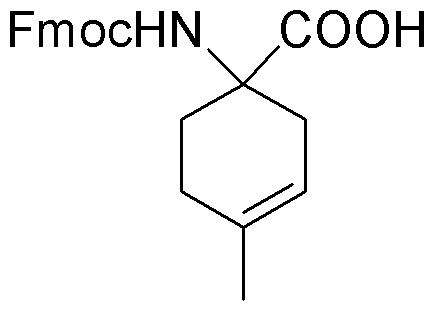1-(Fmoc-amino)-4-methyl-cyclohex-3-ene-1-carboxylic acid is widely utilized in research focused on:
- Peptide Synthesis: This compound serves as a key building block in the synthesis of peptides, particularly in solid-phase peptide synthesis, allowing researchers to create complex peptide sequences efficiently.
- Drug Development: It plays a significant role in the pharmaceutical industry for developing new drugs, especially those targeting specific biological pathways, enhancing the efficacy of therapeutic agents.
- Bioconjugation: The compound is used in bioconjugation techniques, facilitating the attachment of biomolecules to surfaces or other molecules, which is crucial in diagnostics and therapeutic applications.
- Research in Organic Chemistry: It is a valuable reagent in organic synthesis, helping chemists explore new reactions and develop innovative synthetic methodologies.
- Material Science: This chemical is applied in creating functional materials, such as polymers and coatings, which can have tailored properties for specific applications in electronics and nanotechnology.
General Information
Properties
Safety and Regulations
Applications
1-(Fmoc-amino)-4-methyl-cyclohex-3-ene-1-carboxylic acid is widely utilized in research focused on:
- Peptide Synthesis: This compound serves as a key building block in the synthesis of peptides, particularly in solid-phase peptide synthesis, allowing researchers to create complex peptide sequences efficiently.
- Drug Development: It plays a significant role in the pharmaceutical industry for developing new drugs, especially those targeting specific biological pathways, enhancing the efficacy of therapeutic agents.
- Bioconjugation: The compound is used in bioconjugation techniques, facilitating the attachment of biomolecules to surfaces or other molecules, which is crucial in diagnostics and therapeutic applications.
- Research in Organic Chemistry: It is a valuable reagent in organic synthesis, helping chemists explore new reactions and develop innovative synthetic methodologies.
- Material Science: This chemical is applied in creating functional materials, such as polymers and coatings, which can have tailored properties for specific applications in electronics and nanotechnology.
Documents
Safety Data Sheets (SDS)
The SDS provides comprehensive safety information on handling, storage, and disposal of the product.
Product Specification (PS)
The PS provides a comprehensive breakdown of the product’s properties, including chemical composition, physical state, purity, and storage requirements. It also details acceptable quality ranges and the product's intended applications.
Certificates of Analysis (COA)
Search for Certificates of Analysis (COA) by entering the products Lot Number. Lot and Batch Numbers can be found on a product’s label following the words ‘Lot’ or ‘Batch’.
*Catalog Number
*Lot Number
Certificates Of Origin (COO)
This COO confirms the country where the product was manufactured, and also details the materials and components used in it and whether it is derived from natural, synthetic, or other specific sources. This certificate may be required for customs, trade, and regulatory compliance.
*Catalog Number
*Lot Number
Safety Data Sheets (SDS)
The SDS provides comprehensive safety information on handling, storage, and disposal of the product.
DownloadProduct Specification (PS)
The PS provides a comprehensive breakdown of the product’s properties, including chemical composition, physical state, purity, and storage requirements. It also details acceptable quality ranges and the product's intended applications.
DownloadCertificates of Analysis (COA)
Search for Certificates of Analysis (COA) by entering the products Lot Number. Lot and Batch Numbers can be found on a product’s label following the words ‘Lot’ or ‘Batch’.
*Catalog Number
*Lot Number
Certificates Of Origin (COO)
This COO confirms the country where the product was manufactured, and also details the materials and components used in it and whether it is derived from natural, synthetic, or other specific sources. This certificate may be required for customs, trade, and regulatory compliance.


